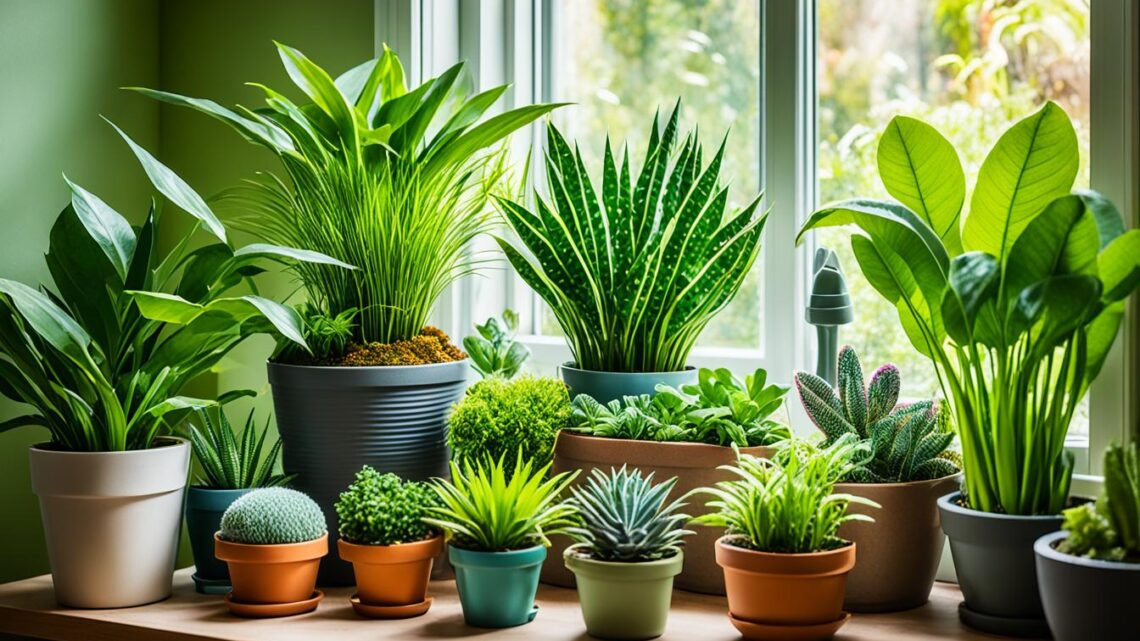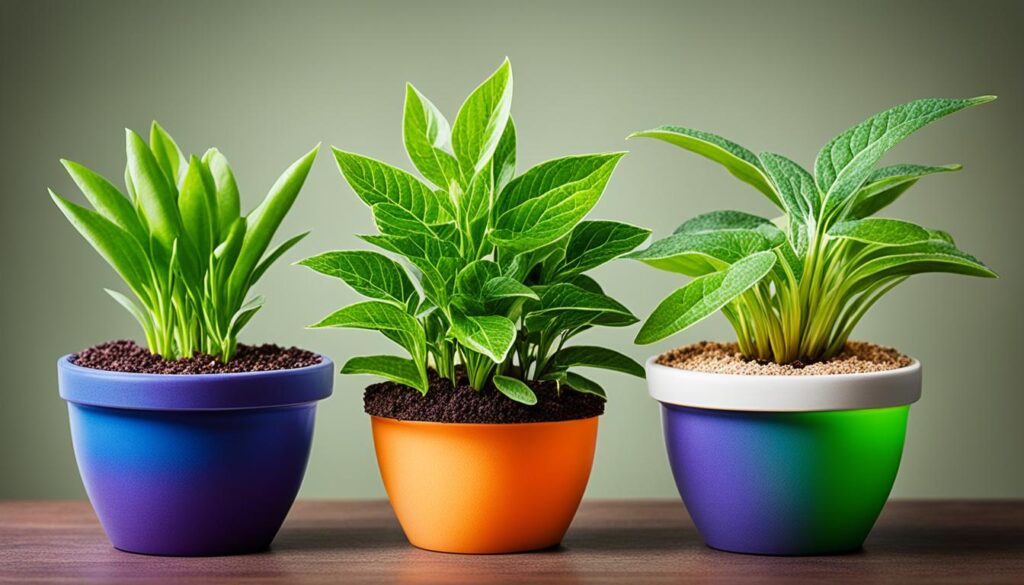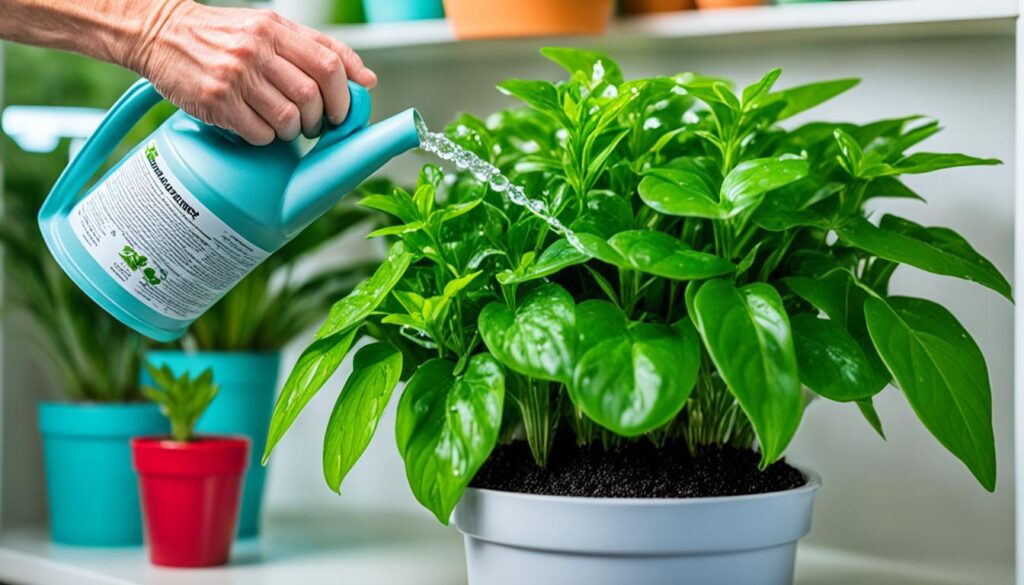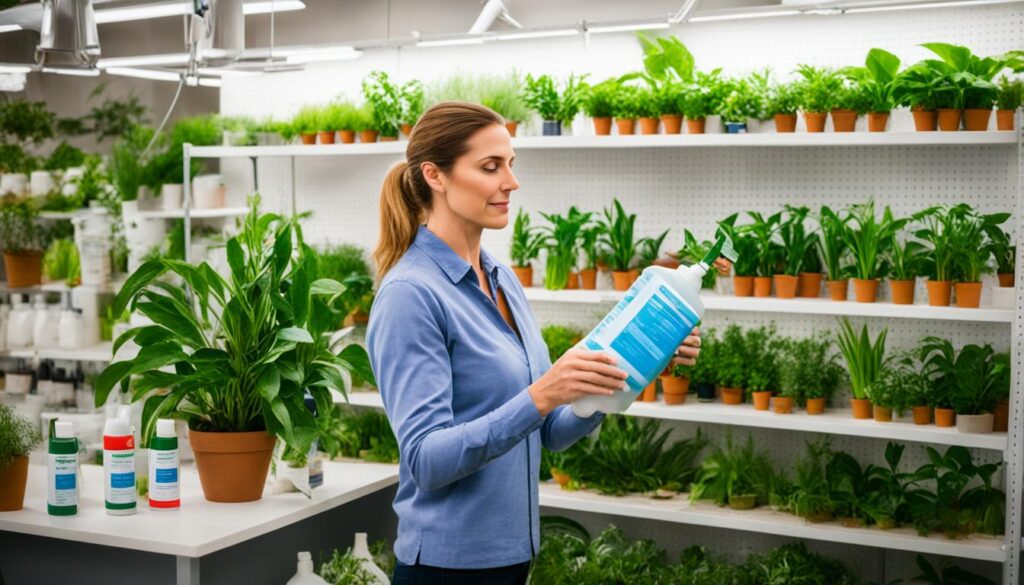
Are you finding it hard to keep your indoor plants healthy and green? The key might be in how you fertilize them. Proper fertilizing techniques play a big role in making your indoor plants grow beautifully. They help in producing more leaves, colorful flowers, and overall healthier plants.
This guide will take you through everything you need to know about houseplant fertilizers. You’ll learn why they are important for plant health. Plus, we’ll share the best ways to keep your indoor plants well-fed and thriving.
Understanding Fertilizers and Their Role
Fertilizers are key for your indoor plants’ health and growth. They provide important nutrients. There are sixteen essential elements for plants. For example, nitrogen, phosphorus, and potassium are crucial for photosynthesis.
Essential Elements for Plant Growth
Plants need macronutrients like nitrogen for leafy growth and phosphorus for strong roots. They also need potassium for flower and fruit development. There are also micronutrients like iron for healthy leaves. Fertilizers help get these nutrients to plants, especially in pots where soil nutrients run low over time.
Types of Fertilizers
Fertilizers can be liquid, granular, or slow-release. Each type has unique benefits. Knowing the differences helps you pick the best one for your plants.
Synthetic vs. Organic Fertilizers
There are synthetic and organic fertilizers for your houseplants. Synthetic fertilizers work quickly but organics are better for the long term. Decide based on what your plants need and what you prefer.
Why Indoor Plants Need Fertilizers
Plants grown indoors are different from those outside. They don’t get a constant flow of nutrients like outdoor plants do. That’s because they are not in contact with organic matter, animal waste, or other natural sources. The potting mix they are in can lose its nutrients over time as plants use them up. This is where fertilizers comes in. They are needed to add back the nutrients so that indoor plants can grow well and look healthy.
Replenishing Nutrients in a Closed System
Indoor plants face a challenge. They don’t have the luxury of getting nutrients from the earth like outdoor plants do. As the plants take in the available nutrients in their pots, these nutrients lessen. This can cause a lack of important elements for the plants. Using the right fertilizers helps solve this issue. It brings back the needed nutrients. This way, indoor plants can get all they need to grow and flourish.
Promoting Healthy Growth and Vibrant Foliage
Adding fertilizers helps more than just restore nutrients in your indoor plants. It also encourages healthy growth, lush foliage, and vibrant blooms. By giving plants the macronutrients and micronutrients they require, you boost their vigor. This makes your indoor plants a lively and lovely part of your home.
The N-P-K Ratio Explained
When you buy fertilizers for your indoor plants, you’ll see three numbers on them. These numbers show the ratio of nitrogen, phosphorus, and potassium – N, P, and K. Each of these elements is key for your plants to grow and stay healthy. They support different parts of your plant’s growth and health.
Nitrogen and Its Role
Nitrogen helps grow lush, green leaves and supports the plant’s overall growth. It’s key in the making of chlorophyll, the stuff that lets plants draw energy from the sun. When your indoor plants have enough nitrogen, they have the energy to do well.
Phosphorus and Its Functions
Phosphorus is needed for strong roots, good blooms, and energy use in your plants. It helps move and store energy for building new cells and tissues. Right levels of phosphorus boost flowering, fruiting, and the vigor of your plants.
Potassium and Its Importance
Known as the «quality» nutrient, potassium helps your plants deal with stress from disease, pests, and dry conditions. It works on the plant’s immune system, water use, and the strength of stems and cell walls. Enough potassium makes your indoor plants look better and last longer.

fertilizing indoor plants
Fertilizing indoor plants is key to keeping them healthy and vibrant. With time, the potting mix indoor plants grow in loses its nutrients. These are critical for plant growth. By using the right fertilizer at the right time, you give indoor plants what they need to flourish. They get macronutrients like nitrogen, phosphorus, and potassium. They also get micronutrients for their growth, bright foliage, and strong flowering or fruiting.
To keep your indoor plant care up, you must know about houseplant fertilizers and how to use them right. This helps fix any nutrient deficiencies and ensures your plants are well-fed. Whether you’re repotting houseplants or helping them grow, it’s important. Keep your plants watered on a schedule and give them the right amount of light. These things make your plants healthier and less likely to have pests or disease. Plus, trimming your plants helps them look better and grow stronger.

When to Fertilize Your Houseplants
Fertilizing your indoor plants at the right time is vital. The ideal period is during the spring through late summer. This phase is their active growth season. They need more nutrients to build new leaves, stems, flowers, and roots.
The Growing Season: Spring to Late Summer
Spring and summer are the key growing months for indoor plants. They benefit a lot from regular feeding. In these seasons, high temperatures and more sunlight make plants grow faster. Providing them with a balanced fertilizer now boosts their health, vivid blooms, and strong leaves.
Actively Growing Plants vs. Dormant Plants
Fertilizer needs change with a plant’s growth phase. Actively growing plants need more feed to keep up their progress. Meanwhile, dormant plants, often seen in the winter, need less. It’s best to reduce feeding in winter to prevent damage from too much fertilizer.

Choosing the Right Fertilizer for Your Plants
When you pick a fertilizer for your indoor plants, think about what each plant needs. A good choice for most plants is a balanced, all-purpose fertilizer. Look for something like 10-10-10 or 20-20-20.
These numbers refer to the amounts of nitrogen, phosphorus, and potassium in the fertilizer. These nutrients are important for indoor plants to grow healthy and look vibrant.
Balanced Fertilizers for General Use
General-purpose houseplant fertilizers are made to help a wide range of indoor plants. They keep the soil nutrient-rich, which is key for plant health and vitality. This is a quick solution for fertilizing multiple houseplants together.
Specialized Fertilizers for Specific Needs
Yet, some indoor plants like orchids or citrus trees may need more than a general fertilizer can offer. For them, you can find specialized fertilizers. These types are formulated to meet the unique needs of specific plants. They ensure your plants get the perfect mix of nutrients for top-notch growth.

Applying Fertilizer Properly
When you fertilize indoor plants, always follow the label instructions. This is especially important for strong, concentrated fertilizers. Dilute them with water as directed. This step helps prevent overfertilization. Too much fertilizer can harm or kill your plants. Using fertilizer correctly is key to keeping your plants healthy and strong.
Diluting Concentrated Fertilizers
Houseplant fertilizers are often sold as concentrates. These must be mixed with water before you use them. Make sure to read and follow the mixing instructions on the label. Correctly diluted fertilizer gives your plants the nutrients they need. This is without the danger of getting too little or too much.
Foliar Feeding vs. Soil Application
There are two main ways to feed your plants: foliar feeding and soil application. Foliar feeding means spraying the leaves. Soil application is adding the fertilizer to the soil. The method you choose depends on your plant’s type and what it needs.
Avoiding Over-Fertilization
Over-fertilizing is a big no-no for indoor plants. It can cause nutrient issues, salt in the soil, or even plant death. Stick to the instructions on the fertilizer package. Watch for any signs of trouble, like yellow leaves or stunted growth. Changing your fertilizing schedule if things seem off will keep your plants in top shape.
Fertilizer Requirements for Popular Houseplants
When it comes to fertilizing indoor plants, each type has its own needs. Fast-growing plants such as Philodendrons, Monsteras, and Pothos do well with regular fertilizing. Use a balanced houseplant fertilizer every 2-4 weeks in the growing season. Slow-growing succulents and cacti, however, need feeding less often. They’re happy with fertilizer made for succulent and cactus plants once a month or every 6-8 weeks.
Orchids, a favorite indoor plant, need a special kind of fertilizer. They love a product that’s high in phosphorus for healthy blooms. For African Violets, use a balanced, slightly acidic fertilizer every 2-4 weeks. Hibiscus and Citrus plants are what we call heavy feeders. They need more frequent fertilizing to keep their leaves green and their flowers or fruit bright.
Focusing on the type of houseplant you have is key. Watch for signs of nutrient deficiencies and adjust your fertilizing as needed. Remember, the right watering, light requirements, and repotting are equally crucial for your plants’ well-being and beauty.



